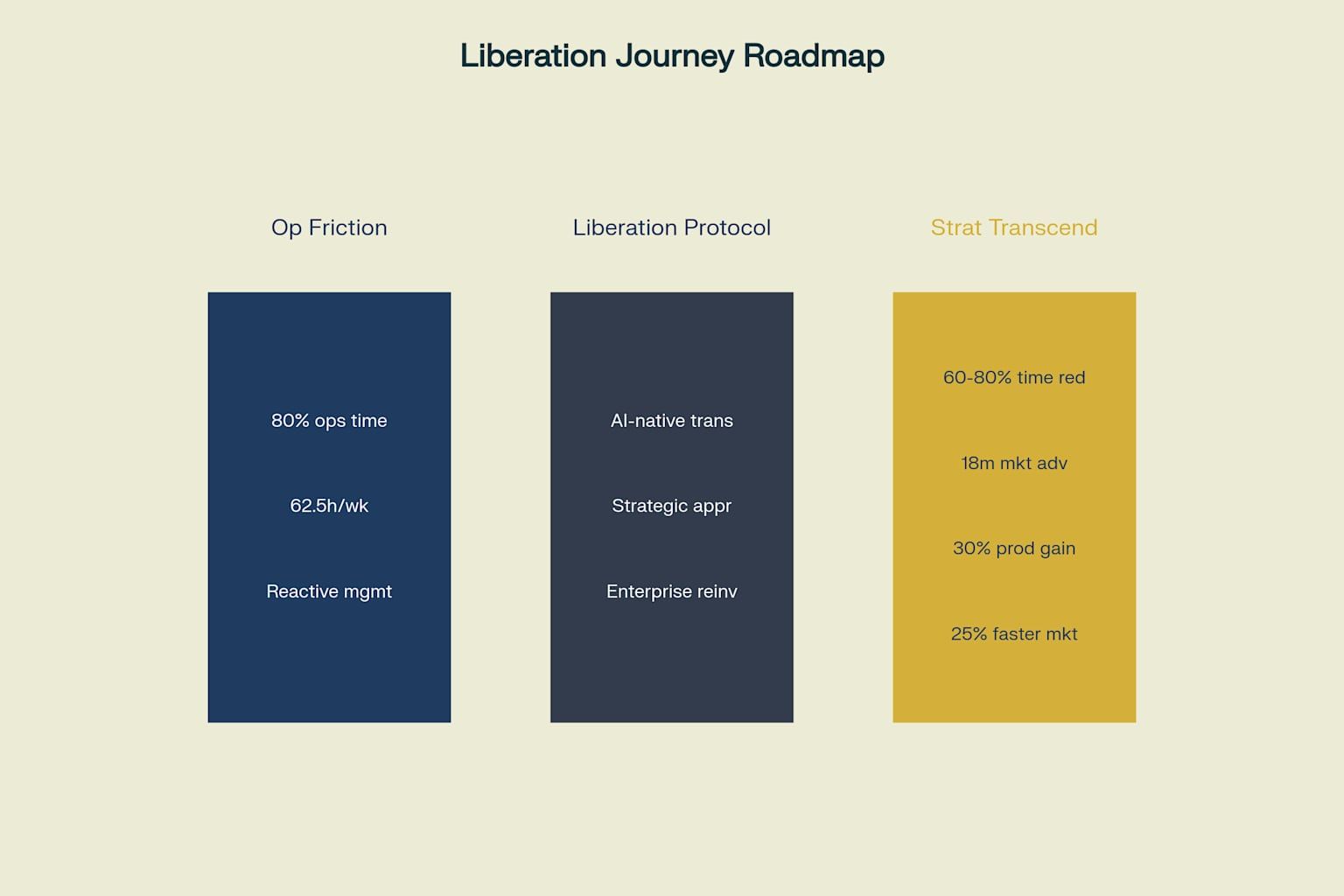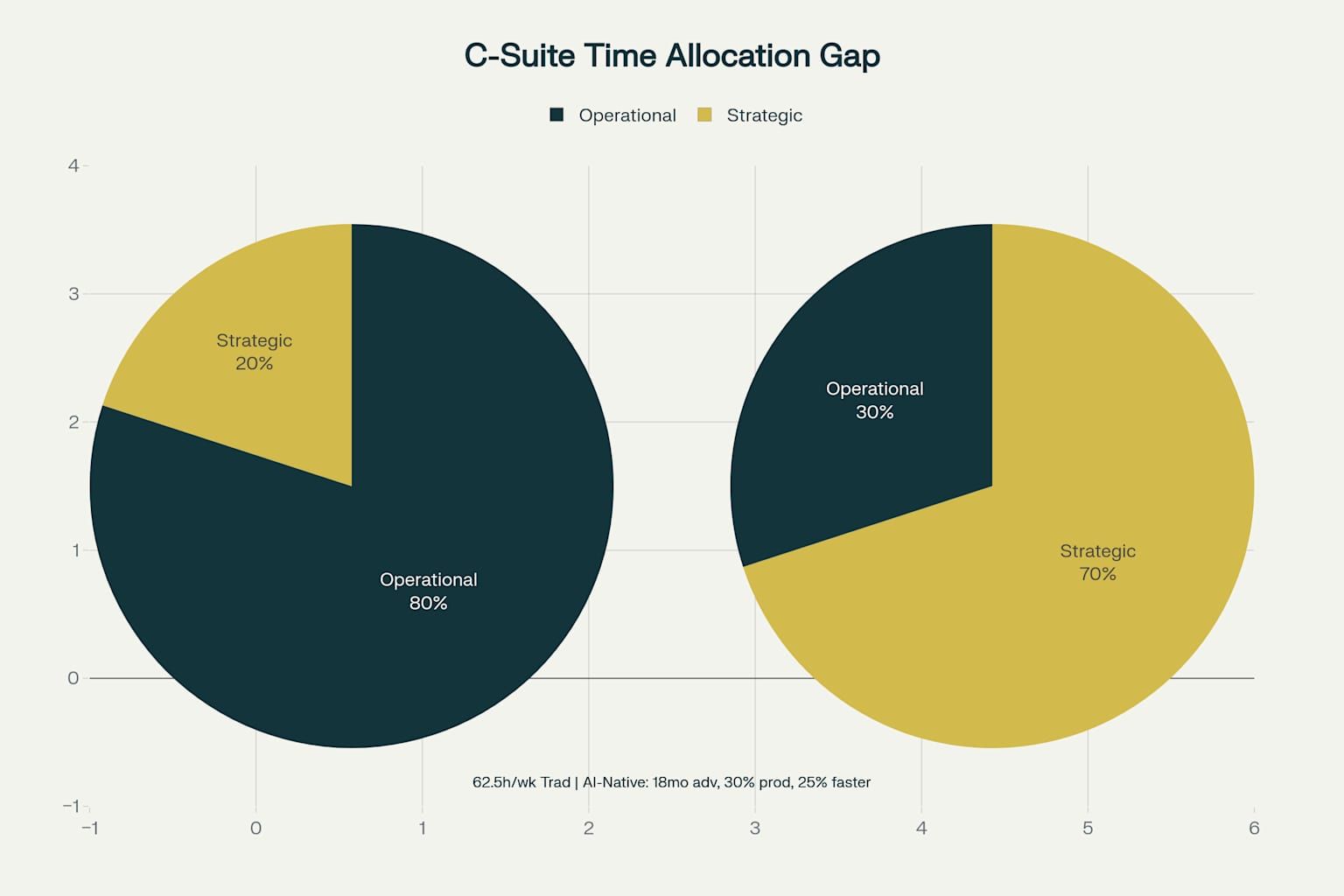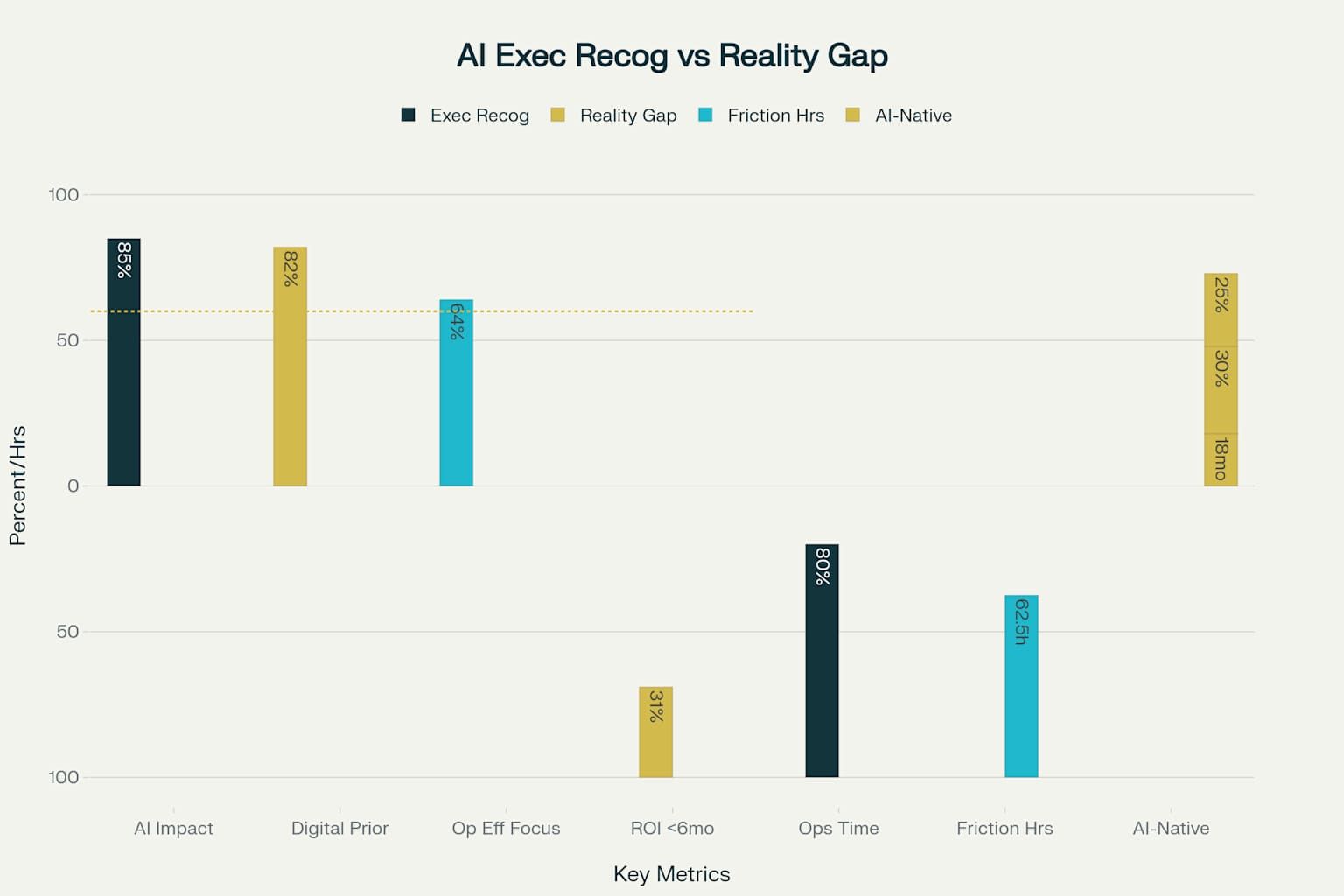Picture this: You’re sitting in your boardroom, surrounded by the latest performance dashboards, drowning in operational updates while your competitors are architecting the future. The executive reality of 2025 is stark—82% of business leaders are prioritizing digital transformation over traditional revenue growth strategies[1][2], yet most remain trapped in the very operational friction that AI was designed to liberate them from.
This isn’t just inefficiency—it’s strategic suffocation. While you’re managing today’s problems, AI-native organizations are operating 18 months ahead of market disruption[3][4], creating what I call “inevitable advantage.” These organizations achieve 30% higher productivity and 25% faster time-to-market[3][5] because they’ve fundamentally reimagined how work gets done.

The Liberation Journey: From Operational Friction to Strategic Transcendence
The Operational Friction Pandemic
The data reveals a disturbing truth: 85% of C-suite executives believe AI will have transformational impact on their businesses[2], yet only 31% anticipate achieving measurable ROI within six months[6]. This paradox isn’t about AI’s capability—it’s about leadership’s approach. Most executives are using AI as a tactical tool rather than a strategic liberation protocol.
The Time Trap Reality: Harvard Business Review’s comprehensive CEO time study reveals that executives work an average of 62.5 hours per week, with 79% working weekends and 70% working holidays[7][8]. Yet 80% of this time is consumed by operational decisions instead of strategic vision[9][10]. Meanwhile, AI-native companies are achieving unprecedented competitive advantages through strategic transcendence.

C-Suite Time Allocation: The Strategic Gap – Traditional vs AI-Native Executive Time Management
The Liberation Protocol: From Operational Friction to Strategic Transcendence
The companies experiencing true transformation aren’t just implementing AI—they’re undergoing enterprise-level reinvention. They understand that AI’s power isn’t in automating what exists, but in liberating what’s possible.
Consider the pharmaceutical executive who told me: “We moved from quarterly reviews to real-time strategic positioning. AI didn’t just speed up our processes—it gave us back our strategic minds.” This transformation enabled their leadership team to reclaim 60% of their strategic time while achieving 40% faster decision-making cycles.
The Strategic Multiplication Effect: When properly architected, AI becomes your strategic multiplier, enabling you to operate as a pure strategist rather than a reactive manager. Organizations implementing comprehensive AI liberation protocols report:
- Strategic Time Recovery: 60-80% reduction in operational decision-making time
- Competitive Velocity: 18-month market advantage over traditional competitors
- Decision Acceleration: 40% faster strategic decision cycles
- Innovation Capacity: 3x increase in transformational initiative capacity[4][5]
The Competitive Chasm Widens
Organizations embracing AI-native transformation are creating unprecedented competitive advantages. Research from leading AI-native companies demonstrates they’re growing three times faster than traditional competitors[5], with fundamentally different operating models that prioritize automation, personalization, and insight-based decision-making.
The Disruption Timeline: While 64% of C-suite leaders prioritize operational efficiency improvements[2], AI-native organizations have already achieved operational transcendence. They’re not just more efficient—they’re more intelligent, more adaptive, and more strategically agile[11][12]. The window for transformation is narrowing as companies that fail to architect their Liberation Protocol now will find themselves competing against organizations that have already achieved strategic supremacy.

The AI Transformation Imperative: Executive Recognition vs Reality Gap – Key Metrics Dashboard
Your Liberation Moment
The question isn’t whether you can afford to transform—it’s whether you can afford not to. Every day you remain trapped in operational quicksand is another day your competitors gain strategic altitude. The statistics are unforgiving: with 85% of executives recognizing AI’s transformational impact yet only 31% able to measure ROI within six months[6][2], the gap between recognition and realization represents the greatest executive opportunity of our time.
The Strategic Imperative: The Liberation Imperative isn’t about technology—it’s about the courage to transcend the limitations that keep you managing instead of leading. Organizations that implement comprehensive AI liberation protocols within the next 12 months will achieve the strategic transcendence that defines market leadership for the next decade[12].
Are you ready to architect your liberation from operational friction and claim your position as a strategic visionary? The companies that act now will turn AI into unprecedented competitive advantage. The rest will be catching up.
FOOTNOTES
- https://www.gartner.com/en/newsroom/press-releases/2025-05-06-gartner-survey-shows-half-of-c-suite-execs-considerting-cuts-in-their-function-in-the-2nd-quarter
- https://foundersmag.com/boost-productivity-time-management-for-executives/
- https://www.boardroom-business.com/level-up/strategic-ceo-time-management-xxpn6
- https://www.prophix.com/blog/2024-retrospective-top-4-challenges-for-the-c-suite/
- https://hospitalityinsights.ehl.edu/why-time-management-is-important-for-ceos-executives
- https://www.bcg.com/publications/2023/time-management-for-ceos
- https://www.russellreynolds.com/en/insights/articles/getting-ahead-of-the-looming-c-suite-succession-crisis
- https://www.mckinsey.com/capabilities/people-and-organizational-performance/our-insights/making-time-management-the-organizations-priority
- https://the-cfo.io/2025/01/17/the-roi-puzzle-of-ai-investments-in-2025/
- https://www.processexcellencenetwork.com/digital-transformation/news/c-suite-leaders-prioritize-digital-transformation-operational-efficiency-ai
- https://www.forbes.com/sites/glenngow/2024/09/22/how-ceos-can-overcome-ai-adoption-challenges-strategies-for-2025/
- https://thunderbit.com/blog/top-artificial-intelligence-stats
